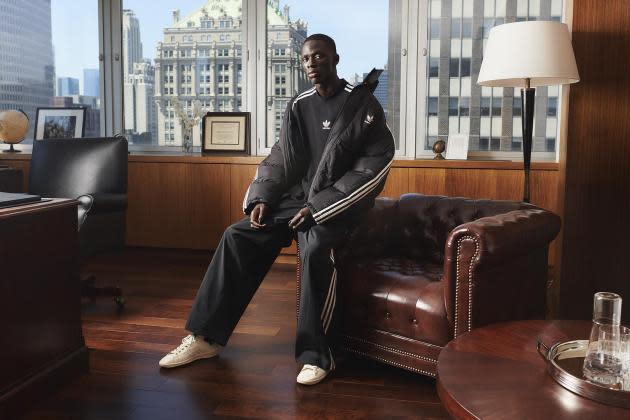Adidas Q3 Results Indicate New CEO Faces a Tough Job

Having had a tumultuous few weeks, executives at Adidas were likely pleased when the company’s shares rose by almost a third this week. The gains came after the announcement that Bjørn Gulden — former boss of competitor Puma — would take the reins at Adidas next year.
But the German sportswear group’s third-quarter results showed Gulden will have a tough job ahead of him.
More from WWD
Adidas was forced to ratchet down full-year guidance for the third time. At the start of 2022, the German brand had expected 11 to 13 percent growth. Now the company predicts only a low-single-digit rate for all of 2022.
Adidas’ net income, which was previously predicted to hit 1.3 billion euros, is now forecast to be less than a quarter of that at 250 million euros.
Between July and September, Adidas sales grew 4 percent to 6.4 billion euros. For the first nine months of the year, sales rose 7.5 percent, in euro terms, to 17.3 billion euros.
“While we continue to face uncertainty externally, we have to focus on the things we can control,” Harm Ohlmeyer, Adidas’ chief financial officer, said during an online press conference.
Kasper Rørsted, who has led Adidas for six years, will officially leave the company on Friday and Ohlmeyer will be in charge until Gulden arrives on Jan. 1.
“The past three years have been marked by several factors that disrupted our business position and it required huge efforts to master these challenges,” Rørsted said Wednesday. “Which is why enabling a restart now is the right decision both for the company, and also for me personally.”
“Bjørn has done a great job at Puma,” Rørsted said, before adding, “I wish him the best of luck.”
Part of the reason Adidas has had to tweak its guidance again was the company’s cutting ties with Ye, the musician formerly known as Kanye West, because of his antisemitic comments, Ohlmeyer said. The musician’s Yeezy line has been key to Adidas’ growth over the last few years.
Gains Adidas had made in July and August, before consumer confidence dipped in Europe during September, were canceled out by the cost of the Yeezy controversy, Ohlmeyer explained.
Adidas said terminating its Ye contract would likely cost it 250 million euros. In its statement this week, the company explained that the “seasonality” of the Yeezy drops played a part in its prognosis — the company usually made around a third of Yeezy sales in the fourth quarter.
Experts have suggested that the total value of the Yeezy collaboration brought Adidas between 1.5 billion euros and 2 billion euros in sales annually.
It is possible that Adidas might try to recoup some of those losses with the Yeezy products or colorways that were already in planning and production, Ohlmeyer suggested. While the company does not own the Yeezy name, Ohlmeyer confirmed that Adidas “is the sole owner of the design rights and preexisting and new colorways.”
Adidas had a dedicated team working on the issue and all options were being reviewed, Ohlmeyer explained. “We might utilize the inventory that we have right now — that is, what was planned and was in production already. That will enable us, if we decide to utilize it in 2023, to compensate for the shortfall.”
Adidas would save around 300 million euros in royalties and marketing if it sold the shoes formerly known as Yeezy, without Ye.
Adidas’ bottom line was also negatively impacted by other one-off events, the company said. This included shutting down operations in Russia because of the war in Ukraine, which “reduced revenues by more than 100 million euros” in the third quarter, Adidas noted in a statement.
Problems are ongoing in China, which was previously one of the company’s “strategic growth markets,” with the brand doing about a third of its business there. But COVID-19-related lockdowns and a political boycott of western brands in China continued to weigh heavily on Adidas. In fact, if one excluded the Chinese market, Adidas sales in the third quarter would have risen 12 percent, currency adjusted, in all other territories, Ohlmeyer pointed out.
In Greater China, Adidas sales dropped 26.6 percent to 937 million euros. This was despite a 7 percent increase in its retail business there.
Adidas also acknowledged excess inventory there, its dependence on Chinese influencers, and inefficient marketing and point-of-sale activities.
The company plans on “right-sizing” its business in China to reflect recent changes, Ohlmeyer said. This might include closing unprofitable retail sites and investing more in key cities.
Sales in the rest of the Asia-Pacific region rose 14.6 percent, Europe 7.4 percent, North America 8.2 percent and Latin America 50.6 percent.
Like other activewear brands, Adidas is suffering from excess inventory. Ohlmeyer cited delayed shipments from Vietnamese factories after a lockdown there, a deliberate stockpiling of product in case of more freight problems such as those experienced during the pandemic, and a downturn in consumer confidence. The result would likely be more discounting, the executive warned.
The costs of marketing, production and distribution continue to increase, along with its retail prices. The brand will continue to raise prices in 2023, Ohlmeyer reported.
The company has also introduced a “business improvement plan to safeguard our profitability in 2023,” the executive explained.
This includes a hiring freeze since mid-September, an increased focus on marketing in key countries and cities, and an “operational excellence program” that is meant to help reduce costs.
All of these measures should help reduce costs at Adidas by 50 million euros in the final quarter of 2022 and should cut them by a further 500 million euros in 2023, Ohlmeyer said.
Analysts from the likes of Deutsche Bank, Warburg Research and Baader Bank greeted Adidas’ third-quarter results with mild optimism, and many were positive that Gulden was the right person to lead the group.
